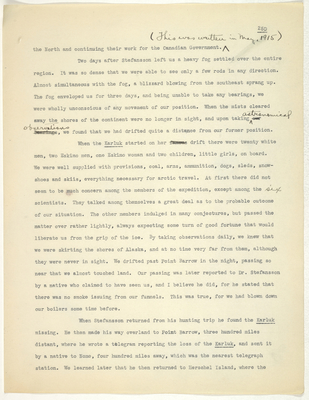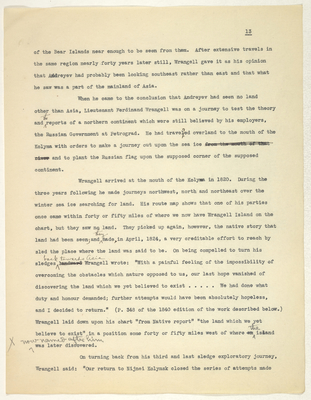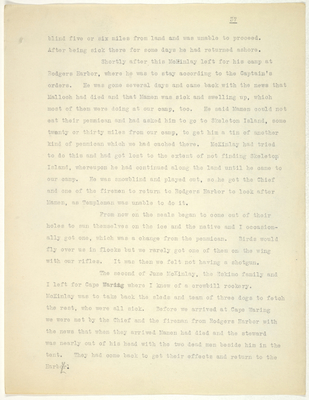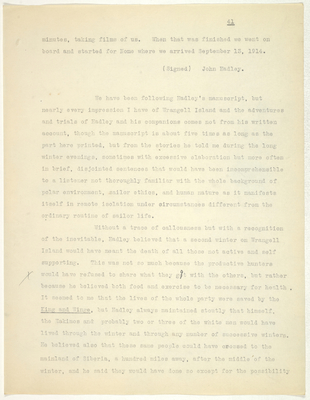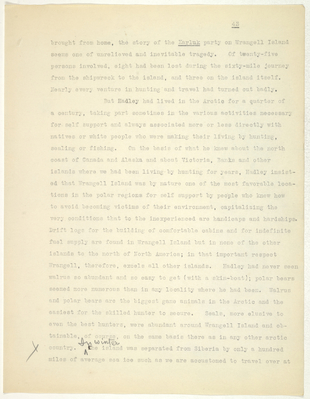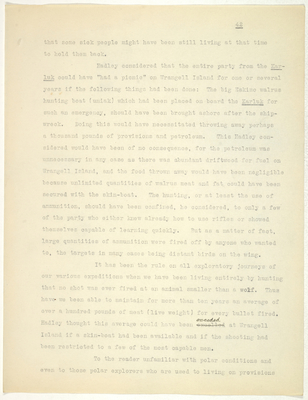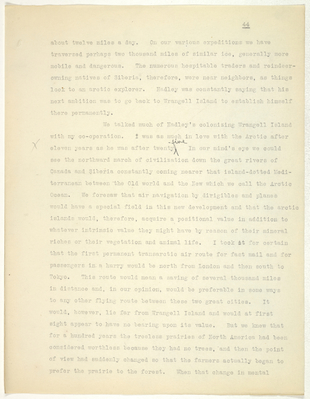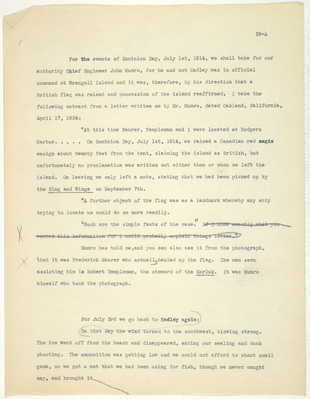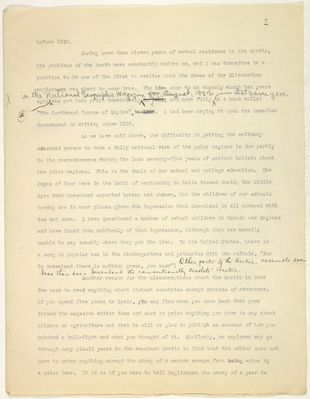Pages That Need Review
stefansson-wrangel-09-26-001
stefansson-wrangel-09-26-001-034
25D
the North and continuing their work for the Canadian Government. (this was written in may, 1915)
Two days after Stefansson left us a heavy fog settled over the entire region. It was so dense that we were able to see only a few rods in any direction. Almost simultaneous with the fog, a blizzard blowing from the southeast sprang up. The fog enveloped us for three days, and being unable to take any bearings, we were wholly unconscious of any movement of our position. When the mists cleared away the shores of the continent were no longer in sight, and upon taking astronomical observations, we found that we had drifted quite a distance from our former position.
When the Karluk started on her famous drift there were twenty white men, two Eskimo men, one Eskimo woman and two children, little girls, on board. We were well supplied with provisions, coal, arms, ammunition, dogs, sleds, snowshoes and skiis, everything necessary for arctic travel. At first there did not seem to be much concern among the members of the expedition, except among the scientists. They talked among themselves a great deal as to the probable outcome of our situation. The other members indulged in many conjectures, but passed the matter over rather lightly, always expecting some turn of good fortune that would liberate us from the grip of the ice. By taking observations daily, we knew that we were skirting the shores of Alaska, and at no time very far from them, although they were never in sight. We drifted past Point Barrow in the night, passing so near that we almost touched land. Our passing was later reported to Dr. Stefansson by a native who claimed to have seen us, and I believe he did, for he stated that there was no smoke issuing from our funnels. This was true, for we had blown down our boilers some time before.
When Stefansson returned from his hunting trip he found the Karluk missing. He then made his way overland to Point Barrow, three hundred miles distant, where he wrote a telegram reporting the loss of the Karluk, and sent it by a native to Nome, four hundred miles away, which was the nearest telegraph station. We learned later that he then returned to Herschel Island, where the
stefansson-wrangel-09-26-001-018
13
of the Bear Islands near enough to be seen from them. After extensive travels in the same region nearly forty years later still, Wrangell gave it as his opinion that Andreyev had probably been looking southeast rather than east and that what he saw was a part of the mainland of Asia.
When he came to the conclusion that Andreyev had seen no land other than Asia, Lieutenant Ferdinand Wrangell was on a journey to test the theory and [the] reports of a northern continent which were still believed by his employers, the Russian Government at Petrograd. He had traveled overland to the mouth of the Kolyma with orders to make a journey out upon the sea ice from the mouth of that river and to plant the Russian flag upon the supposed corner of the supposed continent.
Wrangell arrived at the mouth of the Kolyma in 1820. Luring the three years following he made journeys northwest, north and northeast over the winter sea ice searching for land. His route map shows that one of his parties once came within forty or fifty miles of where we now have Wrangell Island on the chart, but they saw no land. They picked up again, however, the native story that land had been seen; and they made, in April, 1824, a very creditable effort to reach by sled the place where the land was said to be. On being compelled to turn his sledges back towards asia Wrangell wrote: "With a painful feeling of the impossibility of overcoming the obstacles which nature opposed to us, our last hope vanished of discovering the land which we yet believed to exist ..... We had done what duty and honour demanded; further attempts would have been absolutely hopeless, and I decided to return." (P. 348 of the 1840 edition of the work described below.) Wrangell laid down upon his chart "from native report" "the land which we yet believe to exist" in a position some forty or fifty miles west of an the island now named after him was later discovered.
On turning back from his third and last sledge exploratory journey, Wrangell said: "Our return to Nijnei Kolymsk closed the series of attempts made
stefansson-wrangel-09-26-001-052
37
blind five or six miles from land and was unable to proceed. After being sick there for some days he had returned ashore.
Shortly after this McHinlay left for his camp at Rodgers Harbor, where he was to stay according to the Captain’s orders. He was gone several days and came back with the news that Malloch had died and that Mamen was sick and swelling up, which most of them were doing at our camp, too. He said Mamen could not eat their pemmican and had asked him to go to Skeleton Island, some twenty or thirty miles from our camp, to get him a tin of another kind of pemmican which we had cached there. McKinlay had tried to do this and had got lost to the extent of not finding Skeleton Island, whereupon he had continued along the land until he came to our camp. He was snowblind and played out, so he got the Chief and one of the firemen to return to Rodgers Harbor to look after Mamen, as Tempieman was unable to do it.
From now on the seals began to come out of their holes to sun themselves on the ice and the native and I occasionally got one, which was a change from the pemmican. Birds would fly over us in flocks but we rarely got one of them on the wing with our rifles. It was then we felt not having a shotgun.
The second of June McKinlay, the Eskimo family and I left for Cape Waring where I knew of a crowbill rookery. McKinlay was to take back the sleds and team of three dogs to fetch the rest, who were all sick. Before we arrived at Cape Waring we were met by the Chief and the fireman from Rodgers Harbor with the news that when they arrived Mamen had died and the steward was nearly out of his head with the two dead men beside him in the tent. They had come back to get their effects and return to the Harbour.
stefansson-wrangel-09-26-001-056
40
out to use as a bird seine. The first cast we got about fifty moulting birds and in all we got about five hundred, so our hungry days were temporarily over.
The first part of September the new ice was strong enough for us to go three miles from shore, where we saw several bear tracks, and several seals but no walrus close enough to shoot. As the season was getting late and no ship had appeared, we thought we were in for another winter and would have to be careful of our cartridges. I had about forty-five and the native around fifty, so we decided we ought not to shoot anything but bears and walrus unless we were pinched.
The sixth of September the weather was fine and the Eskimo and I went out on the floe, as our ducks were getting low, and I was lucky enough to get two seals. When we came ashore in the evening we got the welcome news that the Eskimo woman had caught about fifty pounds of tomcod, the first we had seen, so we went to sleep quite happy with great expectations for the morrow.
Next morning we fished for a while with poor luck and then all hands went back to the tent. About ten o’clock the Eskimo went outdoors. A few minutes afterwards he sang out, "I think I see a ship!" I jumped up and there, sure enough, was a schooner coming along the island about twelve miles off. I told the native to run out to the edge of the ice and attract their attention and he was off like the wind. Shortly afterwards she headed in for the floe where she finally tied up, and our troubles were over. A gang of men climbed over the bow and headed for the beach.
It proved to be the King and Winge of Seattle, owned by Mr. Swenson, who was on board. They had along a moving picture man with his machine and he marshaled us up and down for about ten
stefansson-wrangel-09-26-001-057
41
minutes, taking films of us. When that was finished we went on board and started for Nome where we arrived .
(Signed) John Hadley.
We have been following Hadley's manuscript, but nearly every impression I have of Wrangell Island and the adventures and trials of Hadley and his companions comes not from his written account, though the manuscript is about five times as long as the part here printed, but from the stories he told me during the longwinter evenings, sometimes with excessive elaboration but more often in brief, disjointed sentences that would have been incomprehensible to a listener not thoroughly familiar with the whole background of polar environment, sailor ethics, and human nature as it manifests itself in remote isolation under circumstances different from the ordinary routine of sailor life.
Without a trace of callousness but with a recognition of the inevitable, Hadley believed that a second winter on Wrangell Island would have meant the death of all those not active and self supporting. This was not so much because the productive hunters would have refused to share what they got with the others, but rather because he believed both food and exercise to be necessary for health. It seemed to me that the lives of the whole party were saved by the King and Winge, but Hadley always maintained stoutly that himself, the Eskimos and probably two or three of the white men would have lived through the winter and through any number of successive winters. He believed also that these same people could have crossed to the mainland of Siberia, a hundred miles away, after the middle of the winter, and he said they would have done so except for the possibility
stefansson-wrangel-09-26-001-059
43
brought from home, the story of the Karluk party on Wrangell Island seems one of unrelieved and inevitable tragedy. Of twenty-five persons involved, eight had been lost during the sixty-mile Journey from the shipwreck to the island, and three on the island itself. Nearly every venture in hunting and travel had turned out badly.
But Hadley had lived in the Arctic for a quarter of a century, taking part sometimes in the various activities necessary for self support and always associated more or less directly with natives or white people who were making their living by hunting, sealing or fishing. On the basis of what he knew about the north coast of Canada and Alaska and about Victoria, Banks and other islands where we had been living by hunting for years, Hadley insisted that Wrangell Island was by nature one of the most favorable locations in the polar regions for self support by people who knew how to avoid becoming victims of their environment, capitalizing the very conditions that to the inexperienced are handicaps and hardships. Drift logs for the building of comfortable cabins and for indefinite fuel supply are found in Wrangell Island but in none of the other islands to the north of North America; in that important respect Wrangell, therefore, excels all other islands. Hadley had never seen walrus so abundant and so easy to get (with a skin-boat); polar bears seemed more numerous than in any locality where he had been. Walrus and polar bears are the biggest game animals in the Arctic and the easiest for the skilled hunter to secure. Seals, more elusive to even the best hunters, were abundant around Wrangell Island and obtainable, of course, on the same basis there as in any other arctic country. In winter the island was separated from Siberia by only a hundred miles of average sea ice such as we are accustomed to travel over at
stefansson-wrangel-09-26-001-058
42
that some sick people might have been still living at that time to hold them back.
Hadley considered that the entire party from the Karluk could have "had a picnic" on Wrangell Island for one or several years if the following things had keen done: The big Eskimo walrus hunting boat (umiak) which had keen placed on board the Karluk for such an emergency, should have keen brought ashore after the shipwreck. Doing this would have necessitated throwing away perhaps a thousand pounds of provisions and petroleum. This Hadley considered would have been of no consequence, for the petroleum was unnecessary in any case as there was abundant driftwood for fuel on Wrangell Island, and the food thrown away would have keen negligible because unlimited quantities of walrus meat and fat could have keen secured with the skin-boat. The hunting, or at least the use of ammunition, should have been confined, he considered, to only a few of the party who either knew already how to use rifles or showed themselves capable of learning quickly. But as a matter of fact, large quantities of ammunition were fired off by anyone who wanted to, the targets in many cases being distant birds on the wing.
It has been the rule on all exploratory journeys of our various expeditions when we have been living entirely by hunting that no shot was ever fired at an animal smaller than a wolf. Thus have we been able to maintain for more than ten years an average of over a hundred pounds of meat (live weight) for every bullet fired. Hadley thought this average could hove been exceded at Wrangell Island if a skin-boat had been available and if the shooting had been restricted to a few of the most capable men.
To the reader unfamiliar with polar conditions and even to those polar explorers who are used to living on provisions
stefansson-wrangel-09-26-001-060
44
about twelve miles a day. On our various expeditions we have traversed perhaps two thousand miles of similar ice, generally more mobile and dangerous. The numerous hospitable traders and reindeerowning natives of Siberia, therefore, were near neighbors, as things look to an arctic explorer. Hadley was constantly saying that his next ambition was to go bach to Wrangell Island to establish himself there permanently.
We talked much of Hadley's colonizing Wrangell Island with my co-operation. I was as much in love with the Arctic after eleven years as he was after twenty five In our mind's eye we could see the northward march of civilization down the great rivers of Canada and Siberia constantly coming nearer that island-dotted Mediterranean between the Old world and the New which we call the Arctic Ocean. We foresaw that air navigation by dirigibles and planes would have a special field in this new development and that the arctic islands would, therefore, acquire a positional value in addition to whatever intrinsic value they might have by reason of their mineral riches or their vegetation and animal life. I took it for certain that the first permanent transarctic air route for fast mail and for passengers in a hurry would be north from London and then south to Tokyo. This route would mean a saving of several thousand miles in distance and, in our opinion, would be preferable in some ways to any other flying route between these two great cities. It would, however, lie far from Wrangell Island and would at first sight appear to have no bearing upon its value. But we knew that for a hundred years the treeless prairies of north America had been considered worthless because they had no trees, and then the point of view had suddenly changed so that the farmers actually began to prefer the prairie to the forest. When that change in mental
stefansson-wrangel-09-26-001-055
39-A
For the events of Dominion Day, , we shall take for our authority Chief Engineer John Munro, for he and not Hadley was in official command at Wrangell Island and it was, therefore, by his direction that a British flag was raised and possession of the island reaffirmed. I take the following extract from a letter written me by Mr. Munro, dated Oakland, California, :
"At this time Maurer, Templeman and I were located at Rodgers Harbor.... On Dominion Day, , we raised a Canadian red xxxxx ensign about twenty feet from the tent, claiming the island as British, but unfortunately no proclamation was written out either then or when we left the island. On leaving we only left a note, stating that we had been picked up by the King and Winge on September 7th.
"A further object of the flag was as a landmark whereby any ship trying to locate us could do so more readily.
"Such are the simple facts of the case." If I knew exactly what you wanted this information for I could probably explain things better."
Munro has told me, and you can also see it from the photograph, that it was Frederick Maurer who actually hauled up the flag. The man seen assisting him is Robert Templeman, the steward of the Karluk. It was Munro himself who took the photograph.
For July 3rd we go back to Hadldy again:
On that day the wind turned to the southwest, blowing strong. The ice went off from the beach and disappeared, ending our sealing and duck shooting. The ammunition was getting low and we could not afford to shoot small game, so we got a net that we had been using for fish, though we never caught any, and brought it
stefansson-wrangel-09-26-001-011
before 1930.
During more than eleven years of actual residence in the Arctic, the problems of the North were constantly before me, and I was therefore in a position to be one of the first to realize that the dream of the Elizabethan navigators was about to come true. The idea came to me vaguely about ten years ago; In the National Geographic Magazine for August 1922 was put into print tentatively and more fully that same year in a book called "The Northward Course of Empire." I had been urging it upon the Canadian Government in writing since 1918.
As we have said above, the difficulty in getting the ordinary educated person to take a fully rational view of the polar regions is due partly to the recrudescence during the last seventy-fice years of ancient beliefs about the polar regions. This is the fault of our school and college education. The Popes of Rome were in the habit of mentioning in bulls issued during the Middle Ages that Greenland exported butter and cheese, but the children of our schools to-day are in most places given the impression that Greenland is all covered with ice and snow. I have questioned a number of school children in Canada and England and have found them uniformly of that impression, although they are usually unable to say exactly whre they got the idea. In the United States, there is a song in popular use in the kindergartens and primaries with the refrain, "For in Greenland there is nothing green, you know": Other parts of the Arctic resemble less than does Greenland the conventionally desolate Arctic.
Another reason for the misconceptions about the Arctic is that few care to read anything about distant countries except stories of adventure. If you spend five years in Spain, you may find when you come back that your friend the magazine editor does not care to print anything you have to say about climate or agriculture but that he will be glad to publish an account of how you watched a bull-fight and what you thought of it. Similarly, an explorer may go through many placid years in the remotest Arctic to find that the editor does not care to print anything except the story of a narrow escape from being eating by a polar bear. It is as if you were to tell Englishmen the story of a year in
